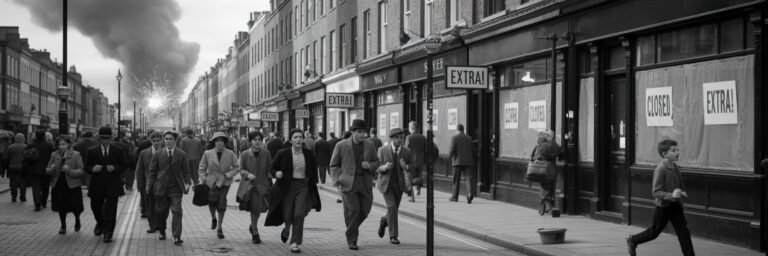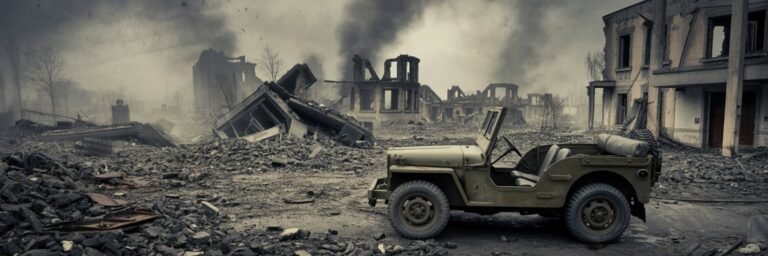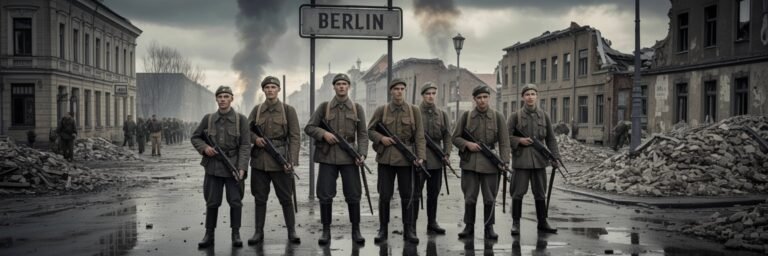World War II (1939–1945) was not only the most destructive conflict in history but also an era of unprecedented technological advancements in weaponry. From small arms to massive battleships, from innovative aircraft to the dawn of nuclear warfare, the weapons of World War II shaped the course of history and influenced military strategy for generations to come.
This article explores the most significant weapons of World War II, examining how they changed the battlefield and revolutionized modern warfare.
1. Small Arms: The Infantry’s Backbone
While tanks and aircraft dominated headlines, small arms were the backbone of every army. Soldiers relied on rifles, machine guns, and submachine guns to fight in the trenches, urban battlefields, and across rugged terrains.
Bolt-Action Rifles
- M1 Garand (USA) – A semi-automatic rifle that gave American troops a firepower advantage over enemies using bolt-action rifles.
- Lee-Enfield (UK) – The standard rifle of the British Army, known for its accuracy and high rate of fire.
- Karabiner 98k (Germany) – A highly effective and widely used bolt-action rifle in the German military.
Submachine Guns
- MP40 (Germany) – A compact and reliable submachine gun, effective in close combat.
- Thompson Submachine Gun (USA) – Famously known as the “Tommy Gun,” it was used by U.S. paratroopers and commandos.
- PPSH-41 (Soviet Union) – With a high rate of fire and drum magazine, it was devastating in urban warfare.
Machine Guns
- Browning M1919 (USA) – A medium machine gun used in almost every U.S. theater of war.
- MG42 (Germany) – Nicknamed “Hitler’s Buzzsaw”, it had a staggering rate of fire (1,200+ rounds per minute).
- DP-28 (Soviet Union) – A light machine gun widely used by Soviet troops against the Germans.
2. Tanks: The War Machines That Ruled the Battlefield
World War II saw the evolution of tanks from simple armored vehicles to highly advanced war machines.
Iconic Tanks of WWII
- Tiger I (Germany) – One of the most feared tanks, with thick armor and a powerful 88mm gun.
- Sherman M4 (USA) – The workhorse of the U.S. Army, known for its versatility and reliability.
- T-34 (Soviet Union) – Widely regarded as one of the greatest tanks of the war, with sloped armor and superior mobility.
- Churchill Tank (UK) – A heavily armored tank used in assaults and breakthrough operations.
Tanks played a pivotal role in battles like Kursk, El Alamein, and the Normandy invasion, shaping military tactics and strategies.
3. Artillery: The King of Battlefield Destruction
Artillery remained the deadliest weapon on the battlefield, capable of destroying enemy fortifications, tanks, and infantry.
Notable Artillery Pieces
- German 88mm Flak Gun – Originally designed as an anti-aircraft weapon, it was used effectively against tanks.
- Katyusha Rocket Launcher (Soviet Union) – A multiple rocket launcher that could devastate enemy positions.
- British 25-pounder – A versatile field gun that provided artillery support for Commonwealth forces.
- M2 105mm Howitzer (USA) – A reliable and powerful field artillery piece used extensively in combat.
4. Aircraft: The Rise of Aerial Warfare
World War II saw the emergence of air superiority as a decisive factor in military victories. The development of fighter planes, bombers, and jet aircraft changed the nature of warfare forever.
Fighter Aircraft
- Supermarine Spitfire (UK) – Played a crucial role in the Battle of Britain, known for its agility and firepower.
- Messerschmitt Bf 109 (Germany) – The backbone of the Luftwaffe, dominating early war air battles.
- P-51 Mustang (USA) – One of the best escort fighters, used to protect bombers deep into enemy territory.
Bombers
- B-17 Flying Fortress (USA) – A strategic bomber that rained destruction on German cities and factories.
- Lancaster Bomber (UK) – Used in famous raids, including the destruction of German dams (Operation Chastise).
- Heinkel He 111 (Germany) – A workhorse of the Luftwaffe during the Blitzkrieg campaigns.
Jet Aircraft
- Messerschmitt Me 262 (Germany) – The world’s first operational jet fighter, introducing a new era of aerial combat.
5. Naval Power: The Dominance of Aircraft Carriers and Battleships
The war at sea was just as intense as on land, with battleships, aircraft carriers, and submarines playing crucial roles.
Battleships and Aircraft Carriers
- Yamato (Japan) – The largest battleship ever built, with massive 18-inch guns.
- Bismarck (Germany) – A powerful German battleship that terrorized the Atlantic before being sunk.
- USS Enterprise (USA) – One of the most decorated aircraft carriers, key in Pacific battles.
Submarines
- U-Boats (Germany) – Devastated Allied supply lines in the Battle of the Atlantic.
- Gato-class Submarine (USA) – Helped cripple Japanese shipping routes in the Pacific.
6. The Dawn of Nuclear Warfare: The Atomic Bomb
The most infamous weapon of World War II was the atomic bomb, developed under the Manhattan Project.
- Little Boy & Fat Man – The two bombs dropped on Hiroshima and Nagasaki (August 1945), bringing a sudden end to the war.
- Nuclear Warfare Began – The use of atomic weapons changed global warfare forever, leading to the Cold War and the arms race.
The Lasting Impact of WWII Weapons
The weapons of World War II reshaped military doctrine and set the stage for modern warfare. Many of the technologies developed—jet aircraft, nuclear weapons, tanks, and submarines—formed the foundation of military arsenals in the Cold War and beyond.
Key Takeaways:
- Tanks and aircraft revolutionized modern combat.
- Aircraft carriers replaced battleships as dominant naval weapons.
- The atomic bomb introduced the threat of global nuclear warfare.
The Technology That Defined an Era
World War II was a war defined by its technological innovations. The weapons developed during this time not only shaped the outcome of the conflict but also transformed the future of warfare.
From the devastating firepower of tanks to the unprecedented impact of nuclear bombs, the conflict introduced weapons that remain legendary in military history. The legacy of these weapons continues to influence modern warfare, defense strategies, and global geopolitics.
Understanding these weapons helps us grasp the scale and impact of World War II, reminding us of the advancements—and dangers—that war can bring to humanity.






